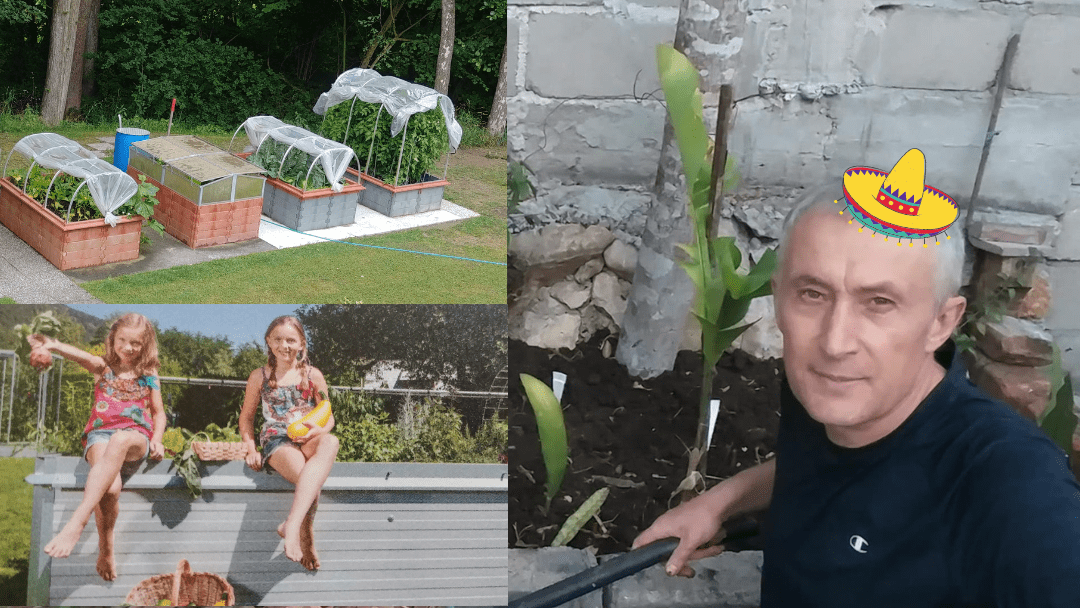Hola, amigos! I am so grateful to continue sharing with you my memories in “The Fine Art of Growing Food in Mexico” series.
In the first episode, I started a Mexican food-growing adventure by inspecting how good is the local gardening soil for planting vegetables at the property of a friend of mine, Rosa. If you missed it or want to recall, read here, but please come back after to see what we can do with that soil after 😉.
You have probably heard of growing vegetables in raised beds before, right? Were you thinking that raised beds are only for growing food in environments where the soil is harsh and not very fertile? Or maybe you were thinking that we grow veggies in raised beds because that’s the only way to do that in the cold climate conditions?
HOWEVER: you know what!?
You can grow food in a raised bed in Mexico too! And that’s what I’d like to share with you in this episode. Can’t you wait? 🙂
After staying in Mexico for several days, I observed that if the rains ever fell, they would be rare. If there was precipitation in the forecast, I would not even consider it to be normal rain, but rather very light and random drizzling. Such minor precipitation is not enough to help even small salad greens to grow up. I’m not speaking about good-sized vegetables yet.
Moreover, Rosa told me it won’t rain from November to April. So what can we do? Especially when she lives in a remote rural area that is disconnected from the main water system. So she regularly has to request to deliver water by the track.
She lives in a private house, and like every house in Mexico, she has a tank large enough to store a month’s water supply for the household. Whereas for drinking purposes, they purchase water in bottles.
As I learned from Rosa, buying water from delivery trucks is the second-most expensive way to receive water in Mexico; only purified drinking water in bottles costs more.
We aimed to start growing edible plants this season. Behind the house, at the back fence of the yard, I discovered a place about three by eight feet in size separated by bricks and some buckets from the rest of the garden.
So I decided to use that space to create a raised bed there for the following three reasons:
- It will be an experiment with small-scale gardening, so imagine it as a sandbox to play in. If no veggies thrive there, no big deal;
- After leaving for Canada at the end of my gardening vacation, I hope that Rosa will have easier access for thinning the plants, weeding if necessary (hopefully not as much 😉 ) and harvesting or course;
- And the most important: since we are dealing with dry weather, she would have to water the garden as little as possible.
If you don’t grow food in a raised bed, I will explain in simple terms so that you might build one in your food garden. It’s simply a box filled up with gardening soil above ground level. You can build such a box with dimensions that you can calculate this way:
- Set the length to fit a certain number of plants to grow in.
- Choose the width so that you can reach any plant without tension. The distance between the tips of your fingers and your nouse is about 3 ft when your arm is extended out to the side. Thus you will truly appreciate the width of a 3 to 5-foot bed where you will be able to fertilize, plant, weed out (if necessary), and harvest from each side with relative ease and without walking on the bed. When you work with a 3-5 ft width, you also allow a good mini-climate to develop between closely spaced plants. However, you might wish to use a narrower bed, 1.5 to 2.5 ft wide, for plants supported by stakes, such as tomatoes, pole beans, and peas, for easier harvesting.
- And finally, set up the height as it fits your gardening style. You can make it as low as you’d be ok leaning down or as high as standing with the top of the bed reaching your beltline.
Before I tell you about how I worked with the local materials to fill the raised bed up, I would like to share the pictures of raised beds that I have seen in the gardens of my friends of mine in Austria.
For example, this raised bed is built up from thick steel sheets that will sustain the matter of time:
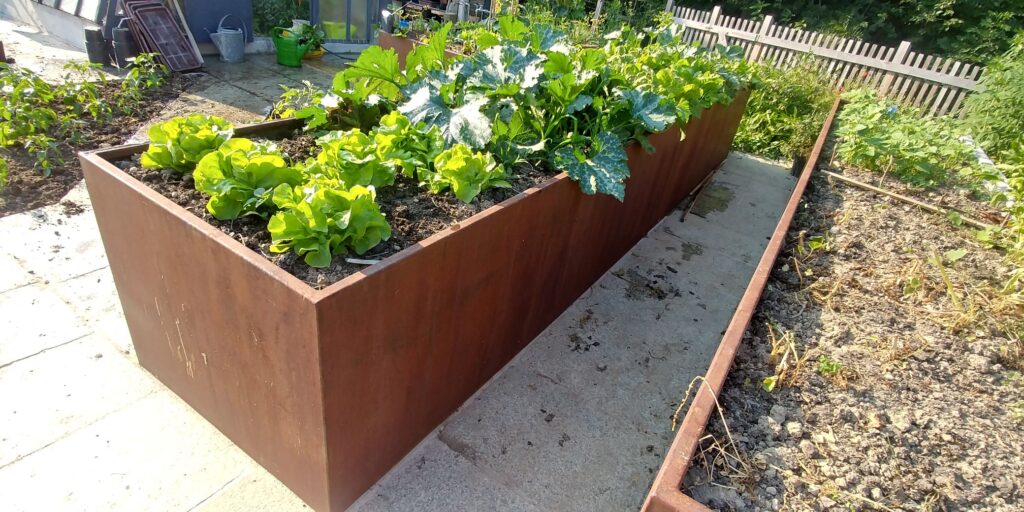
When you look at the set of these raised beds, you will surely notice that the walls were fabricated specifically to interlock in sections:
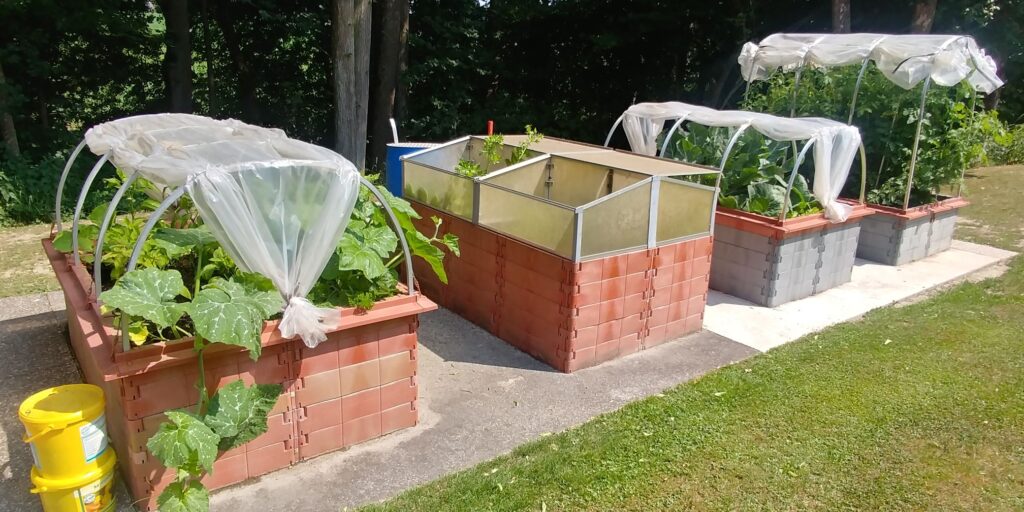
You can find plenty of raised beds made from wooden logs too:
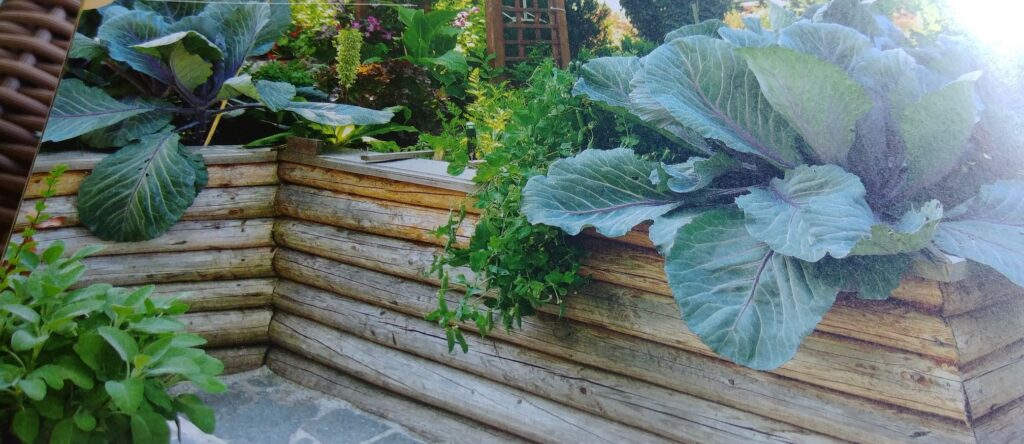
Or as simple as this classic raised bed built from timber and boards:
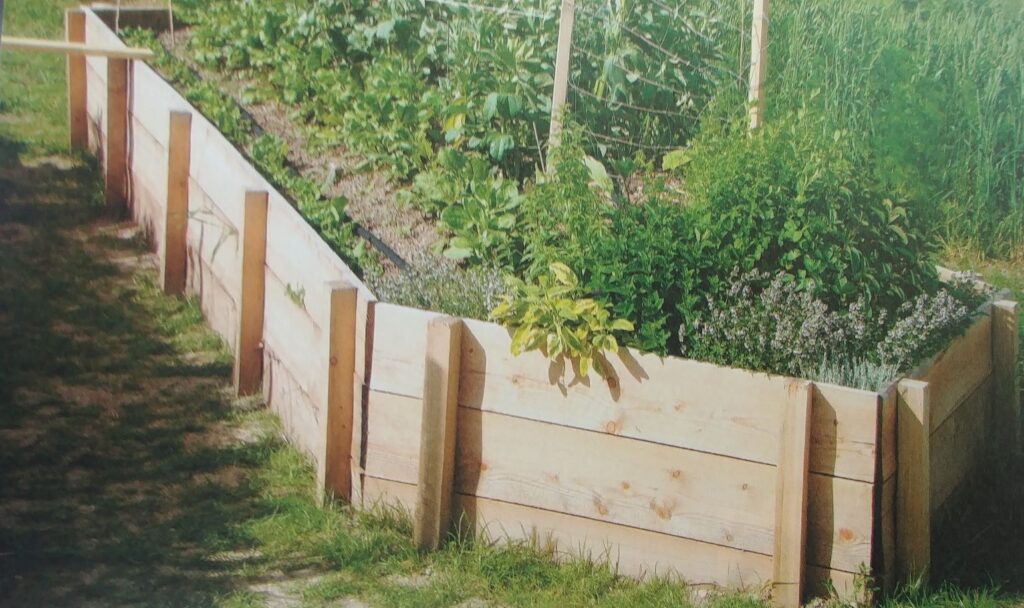
You will impress your neighbour when pulling crispy and fresh lettuce out from the raised bed in your backyard. Unlike you, he has to bend down.
To fill up raised bed in Rosa’s garden, I have collected all possible organic residues from the garden so that no scrap gets wasted. I picked up fallen leaves and branches that lay on the ground for a long without rotting, as the dry weather slows down rotting. When I mix everything in the raised bed, the garden waste will get decomposed by always helpful insects and bacteria. I wish to ask worms to join this army of volunteers. However, I haven’t seen a single one in the soil there. Hopefully, the worms crawl closer to the surface during the rainy season.
After this, we have to stomp on the garden waste to compact it a bit. Therefore we top it up with a good layer of soil. The soil will help the natural process of decomposition go faster.
Once we prepare this beautiful rustic raised bed with all its content, we should keep it evenly moist until and after planting so that macrobiotic life and plants stay alive. For this purpose, I watered the soil as much as I could to settle down the soil. The greywater I used was an excellent find because its nutrient load gives the soil an extra boost and disarms my possible guilt about using lots of water.
Meanwhile, take a break from reading and watch the whole adventure of preparing the soil inside the raised bed:
Before planting the seeds, make sure to wait for a couple of days until the soil gets settled. When you’re going to make a raised bed for yourself I strongly suggest covering the finished bed with a tarp to retain moisture on sunny days and keep moisture from evaporating right away. After that, make sure to plant beds as soon as possible. Then plants could take advantage of the new surge of life made possible by mixing the soil, organic garden waste, air, water and sunlight. Luckily these days weren’t as hot as they could be. I hope the soil still holds the moisture from the watering I provided while filling up raised bed.
To begin with, I planted zucchini and squash seeds along the edges. I selected zucchini and squash specifically as their leaves serve as ground cover to shade the soil. Placing zucchini along the wall will give them a chance to climb. Also, there is a tree standing right at the fence line. I hope the zucchini and squash vines will spiral the trunk with lovely hugs.
In the middle of the bed, I planted a row of cayenne peppers. I imagined pepper plants growing like trees along the center line of the bed with squash and zucchini occupying the whole ground under them.
Don’t be surprised by the markings that were there before I started shooting the video. I marked the spots where the seeds of zucchini dropped with white marks and the spots of squash with wood sticks. By the way, those are the butternut squash seeds.
The next step is to water the plants, but be careful with tiny pepper seeds because they may float up and face the sun. As a result, they will be dried out and won’t germinate. To avoid that I made sure to insert pepper seeds deeper into the soil and don’t overwater them.
As you know, this is all happening in South Mexico, where no rain is predicted between November and April. I was there in January. So if we don’t want the soil to dry right away, we have to cover the soil with mulch. Same as before, I have used garden debris as mulch material. Also with the mulch, you achieve the following advantages:
- Protect soil from erosion: since the weather is windy, the top layer of the soil gets wiped out and dries out quickly. The blanket of mulch will shelter the soil from erosion.
- Retain moisture inside the soil: the mulch won’t allow water to evaporate back into the air quickly. The mulch allows the moisture to stay longer inside the ground.
- Hold the soil cooler: the air warms up to 26 to 28C on average here, so the mulch helps to keep the soil several degrees cooler.
- Prevent weeds from sprouting: if any weeds grow, the soil will act as a barrier. As a result, it will be hard for weeds to go through the mulch layer.
- Enhance the compost: the buried inside of raised bed garden waste will be decomposed in the soil, and the top layer of the mulch will eventually get converted into compost as well.
- Help build the soil structure: adding organic materials to the soil, like garden waste and mulch, maintains the nutritious soil structure. Moreover, this way, we support the local garden ecosystem where the components fertilize the soil, feed the plants, and those will produce delicious veggies.
On this happy note, I invite you to review a short video on planting raised beds:
Once you’ve had a chance to watch it, I’d love to hear from you.
If you’d like to experience food growing in your yard, watch the videos that I have created, and in the comments below, tell me:
- What you’re working on right now in your vegetable garden
- What veggies you’d like to grow this year
- Is there anything that’s stopping you
Share as much detail as possible in your reply.
The biggest takeaway message we can hold onto is this. It’s not about finding the best ready-to-go plant with fruits hanging on the vine but about playing with what you have in your possession and creating the environment where your plants will thrive.
P.S. In the upcoming episode, I will invite you to the Mexican farmers market where local people sell their plants, fruits, and vegetables. In meanwhile, if you are a true food garden lover, click HERE to join GardenHowTo online gardening club as one of the founding members.

